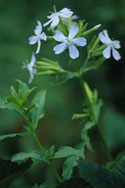
Photo © Steven Foster
Introduction
Soapwort is a perennial that grows to 1 to 2 feet, with 5-petaled white, pink or lavender flowers from late spring through summer.1,2 Soapwort is native to the temperate regions of Europe, North America, and Asia.3 The dried roots or rhizomes of soapwort are the most used part of the plant due to the saponin content which allows them to produce a foaming lather.1,2 History and Cultural Significance
During the Middle Ages, Dominican and Franciscan monks brought soapwort from northern Europe to England as “a gift of God intended to keep them clean.”2 Soapwort continued to be used as a dish and laundry soap until, in 1597, John Gerard’s Herbal expanded its use to a topical disinfectant for “filthy diseases” and “green wounds”.2 During the early days of the textile industry, soapwort was used as a sizing and cleaning component of the process called ‘fulling’ leading to the nickname Fuller’s Herb.2 The Pennsylvania Dutch found an unusual use for soapwort, that is, for producing a foamy head on beer.2 Soapwort is used as a low-lather shampoo specifically for sensitive skin and damaged or delicate hair.4 Soapwort is also an effective, gentle cleanser for fragile fabrics that would be damaged by synthetic detergents.5 Modern Research
No current documented studies are being performed on the external uses of soapwort. Research is being performed on soapwort in order to determine additional active chemical constituents and their potential uses.6 Future Outlook
Soapwort is currently listed as a troublesome weed in Colorado and as a potential invader weed in Australia.7,8 Soapwort’s invasive and aggressive growing behavior competes with other plants for moisture, nutrients, and light. As soapwort becomes an economic and environmental nuisance, it could face possible eradication in some areas.8 References
1 van Wyk BE, Wink M. Medicinal Plants of the World: An Illustrated Scientific Guide to Important Medicinal Plants and their Uses. Portland, OR: Timber Press, 2004. 2 DerMarderosian A, Beutler JA, eds. The Review of Natural Products: The Most Complete Source of Natural Product Information. 3rd edition. St. Louis, MO: Facts and Comparisons, 2002. 3 Chevallier A. The Encyclopedia of Medicinal Plants. London: Dorling Kindersley Ltd.; 1996. 4 Medicinal, Culinary and Aromatic Crops: Soapwort. Alberta Agriculture, Food and Rural Development website. November 6, 2001. Available at: http://www.agric.gov.ab.ca/crops/special/soapwort.html. Accessed October 4, 2004. 5 Plants for a Future: Database Search Results: Saponaria officinalis. ibiblio website. Available at: http://www.ibiblio.org/pfaf/cgi-bin/arr_html?Saponaria+officinalis. Accessed October 4, 2004. 6 No authors stated.[In process citationIn Russian]. Vopr Pitan. 2004;73(2):32-33. 7 Noxious Weeds and Non-Native Plants. Colorado Weed Management Association website. 2003. Available at: http://www.cwma.org/2_bad_weed.html. Accessed October 5, 2004. 8 The Invasive Species Initiative. The Nature Conservancy website. April 2004. Available at: http://tncweeds.ucdavis.edu/global/australia/car.html. Accessed October 4, 2004.
|